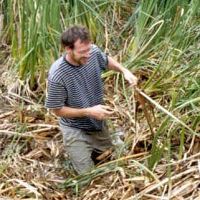Bales et al., 2018
Mechanisms controlling the impact of multi-year drought on mountain hydrology
Bales, R. C.; Goulden, M. L.; Hunsaker, C. T.; Conklin, M. H.; Hartsough, P. C.; O'Geen, A. T.; Hopmans, J. W.; Safeeq, M. (2018)
Hydrological Processes: 10.1038/s41598-017-19007-0
-
Sierra, INVESTIGATOR
-
Sierra, INVESTIGATOR
-
Sierra, INVESTIGATOR
-
Sierra, INVESTIGATOR
-
Sierra, INVESTIGATOR
-
Sierra, COLLABORATOR
-
Sierra, INVESTIGATOR
Abstract
Location map. Background is false color Landsat 5 Thematic Mapper image for September 4, 2011 (red is band 5, green is band 4, blue is band 3), the year prior to the drought. The blue polygon is the Upper Kings River watershed, above Pine Flat Reservoir. The city of Fresno is at the southwestern corner of the image. Black circles are the 3 focal measurement sites, right to left: San Joaquin, Soaproot Saddle, Providence Creek. Insert in lower left shows location of the Kings River basin within California. Photos show recent tree mortality in southern Sierra Nevada Pine-Oak and mixed-conifer forests, in the vicinity of Soaproot Saddle. Photo: Margot Wholey, Dec 17, 2015.
Mountain runoff ultimately reflects the difference between precipitation (P) and evapotranspiration (ET), as modulated by biogeophysical mechanisms that intensify or alleviate drought impacts. These modulating mechanisms are seldom measured and not fully understood. The impact of the warm 2012–15 California drought on the heavily instrumented Kings River basin provides an extraordinary opportunity to enumerate four mechanisms that controlled the impact of drought on mountain hydrology. Two mechanisms intensified the impact: (i) evaporative processes have first access to local precipitation, which decreased the fractional allocation of P to runoff in 2012–15 and reduced P-ET by 30% relative to previous years, and (ii) 2012–15 was 1 °C warmer than the previous decade, which increased ET relative to previous years and reduced P-ET by 5%. The other two mechanisms alleviated the impact: (iii) spatial heterogeneity and the continuing supply of runoff from higher elevations increased 2012–15 P-ET by 10% relative to that expected for a homogenous basin, and iv) drought-associated dieback and wildfire thinned the forest and decreased ET, which increased 2016 P-ET by 15%. These mechanisms are all important and may offset each other; analyses that neglect one or more will over or underestimate the impact of drought and warming on mountain runoff.
Citation
Bales, R. C.; Goulden, M. L.; Hunsaker, C. T.; Conklin, M. H.; Hartsough, P. C.; O'Geen, A. T.; Hopmans, J. W.; Safeeq, M. (2018): Mechanisms controlling the impact of multi-year drought on mountain hydrology. Hydrological Processes: 10.1038/s41598-017-19007-0. DOI: 10.1038/s41598-017-19007-0
 This Paper/Book acknowledges NSF CZO grant support.
This Paper/Book acknowledges NSF CZO grant support.
Explore Further








